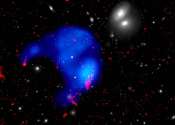Cosmic rays may be key to understanding galactic dynamics
Cosmic rays are charged subnuclear particles that move close to the speed of light, constantly raining down on the Earth. These particles are relativistic, as defined by Albert Einstein's special relativity, and manage to ...









